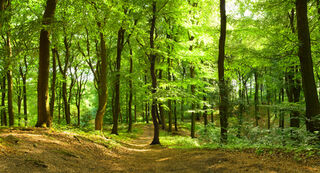ADHD
Nature's Rx: Green-Time's Effects on ADHD
Green time may prove to be a powerful natural treatment for ADHD symptoms.
Posted June 20, 2013 Reviewed by Ekua Hagan

While some of my previous posts have focused on the disorganizing effects of screentime on the brain (e.g. "Screens and the Stress Response" and "Wired and Tired"), this post explores the flip side of environmental influences: the organizing effects of green time. More specifically, we’ll look the research suggesting greenery improves concentration, impulse control and hyperactivity in children.
We’ve all heard the sage advice to “spend more time in nature,” but we don’t always follow it. Though virtually all of us believe nature to be therapeutic, it can be reinforcing to hear how this adage is supported by solid research—and might even push us to act accordingly.
Researchers Dr. Frances Kuo and Andrea Faber Taylor out of University of Illinois’ Landscape and Human Health Laboratory have dedicated themselves to studying the relationship between physical environment and wellness. Below are some important findings and discussion points from their research on the relationship between greenery and ADHD symptoms:
- Taylor, Kuo & Sullivan, 2001. “Coping With ADD: The Surprising Connection to Green Play Settings” (Environment & Behavior) This study examined ADD children’s attention after playing in a variety of settings. Findings indicated green settings improved attention, and that the greener the setting the better the attention. The article includes an interesting discussion on the research and mechanisms behind attentional fatigue and restoration—which in itself is worth reading.
- Kuo & Taylor, 2004. “A potential natural treatment for Attention-Deficit/Hyperactivity Disorder: Evidence from a national study." (American Journal of Public Health) The conclusion reached here was that green outdoor settings improve ADHD symptoms in children regardless of gender, socioeconomic status, or living environment (rural, urban, etc.) This held true even when the type of activity was matched across different settings. In other words, the benefits seen with green settings were not solely due to the type of activities that being outdoors allows (freedom of movement, burning off hyperactivity, dynamic stimulation, etc.)—but were due to the green setting itself.
- Taylor and Kuo, 2009. “Children With Attention Deficits Concentrate Better After Walk in the Park." (Journal of Attention Disorders) Here they examined children’s attention (by testing digit span backward) after taking a 20-minute walk in three different settings—park, neighborhood, and downtown. The urban settings were well-kept and noise-level and pedestrian density were roughly equal across all three settings. A puzzle activity was given to each child prior to the walk to induce some level of attentional fatigue. Not surprisingly, the park walk proved superior to the other two settings. What was surprising however was the large effect size—which was similar to that of Ritalin! The findings, because each child performed the task in all three settings (in random order) suggested causation rather than mere association.
- Taylor & Kuo, 2011. Could exposure to everyday green spaces help treat ADHD? Evidence from children’s play setting (Applied Psychology Health and Well Being). These results demonstrated ongoing reductions in ADHD symptoms for children with regular exposure to play in green spaces. Additionally, the study suggested that hyperactivity benefitted more from open green space.
- Other research has demonstrated nature’s effects on hyperactivity and impulse control:
- Wells, 2009. At home with nature: effects of “greenness” on children’s cognitive functioning. (Environ Behav) This researcher tested cognitive functioning on children from poor urban environments pre- and post-moving to a new home. Children whose move provided the most improvement in greenness also showed the most improvements in cognitive testing.
- Taylor, Kuo & Sullivan 2002. Views of nature and self-discipline: evidence from inner-city children. (J Environ Psychol) This study found some protective factors with green settings: The more natural view a girl could see from her home, the better her impulse control and self discipline. This important study suggests close and regular viewing of greenness may reduce inherent risks associated with poor urban settings, at least for girls.
- Kuo & Sullivan, 2001. Aggression and violence in the inner city: impacts of environment via mental fatigue. (Environ Behav.) This fascinating study proposed that mental/attentional fatigue triggers dysregulation, anger outbursts, and aggression, while restorative green settings reduce it. Residents with the most barren environments demonstrated more mental fatigue (inability to direct and sustain attention), aggression, and violence, compared to those residents who lived in greener environment (more trees, grass, etc.) This suggests that nature restores calmness in the nervous system, via the restorative effects of effortless attention, while lack of attention restoration promotes mental fatigue and irritability. The implications of this study are enormous!
Whether a child has ADHD or not, even mild mental health issues in children can cause inattention, hyperactivity and/or impulsivity. Here we have a natural intervention that can help avoid use of psychotropic drugs, promote overall physical health, decrease the stress response, support brain integration and development, and improve psychosocial functioning. What’s not to love?
And while these studies examine relatively short-term effects of green time on the brain, remember that “what gets fired gets wired.” Green time promotes long-term gains in attention and impulse control—domains which largely shape how well our brain functions, and therefore how well we function in school, work, relationships, and health. Green time is a truly solid investment in mental wealth.


